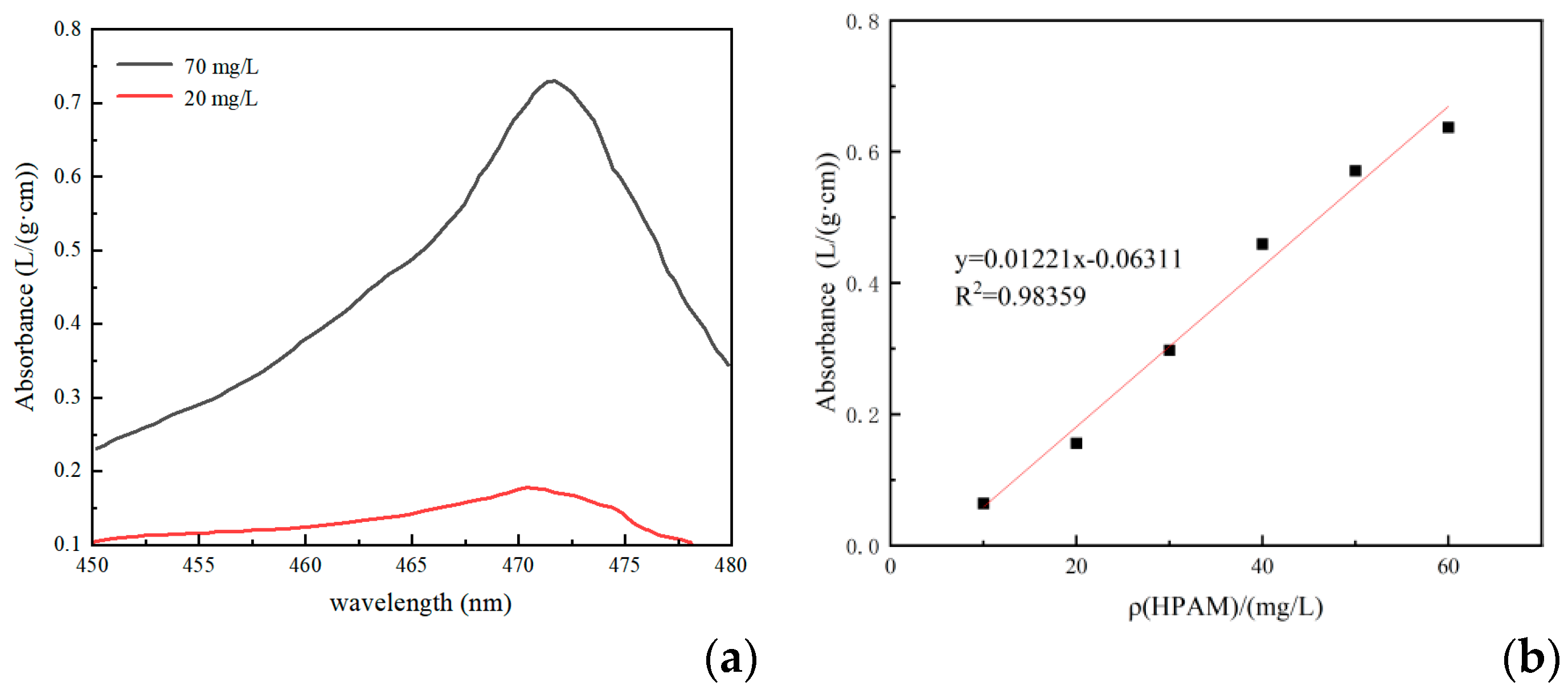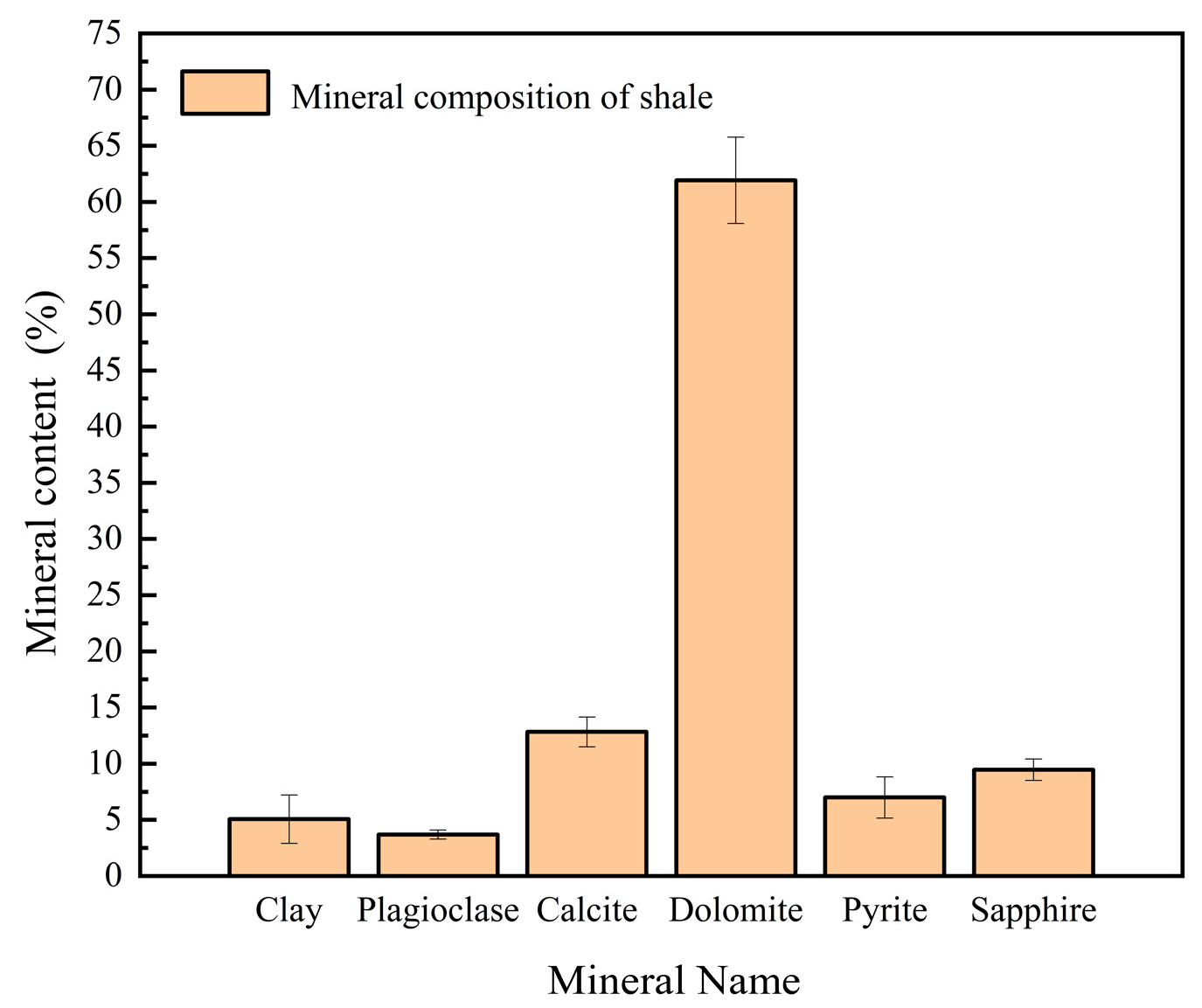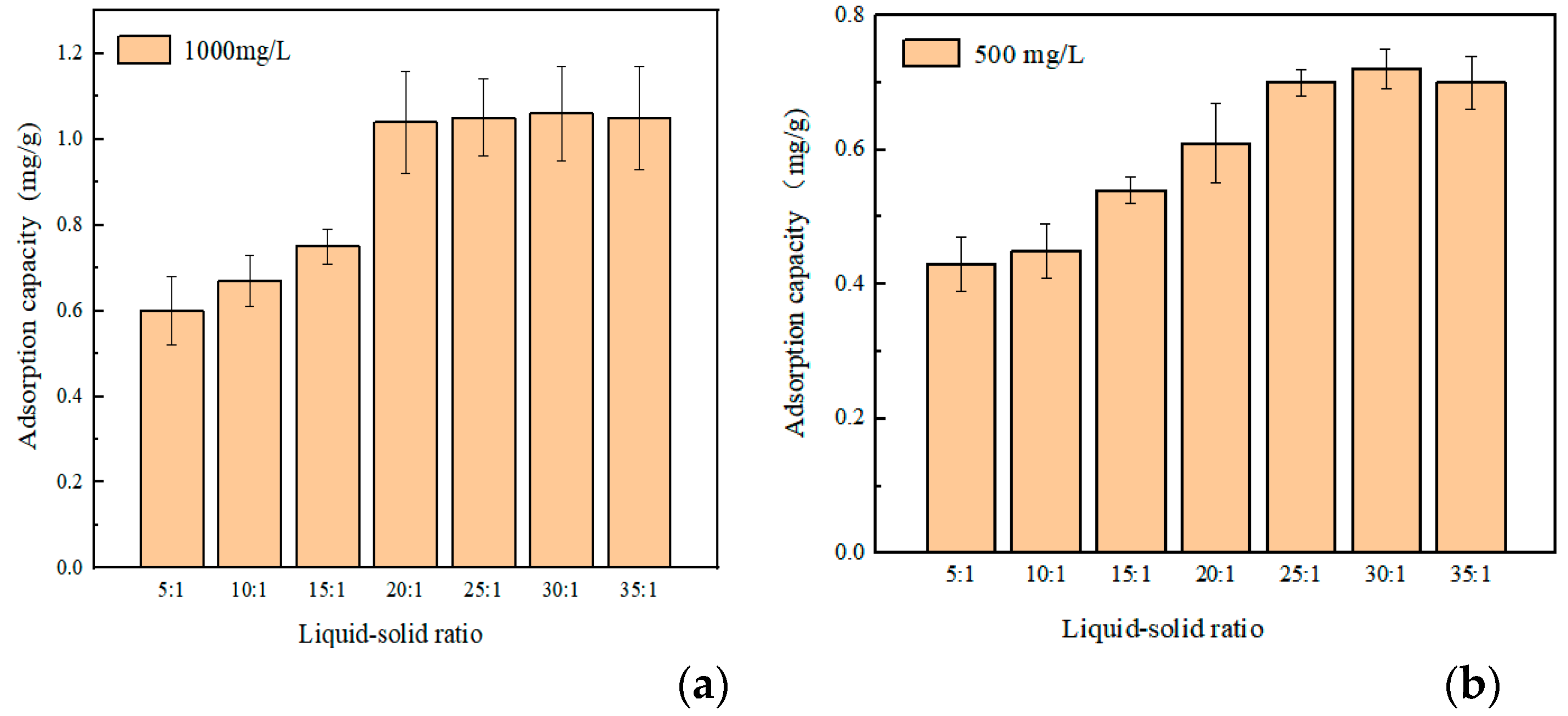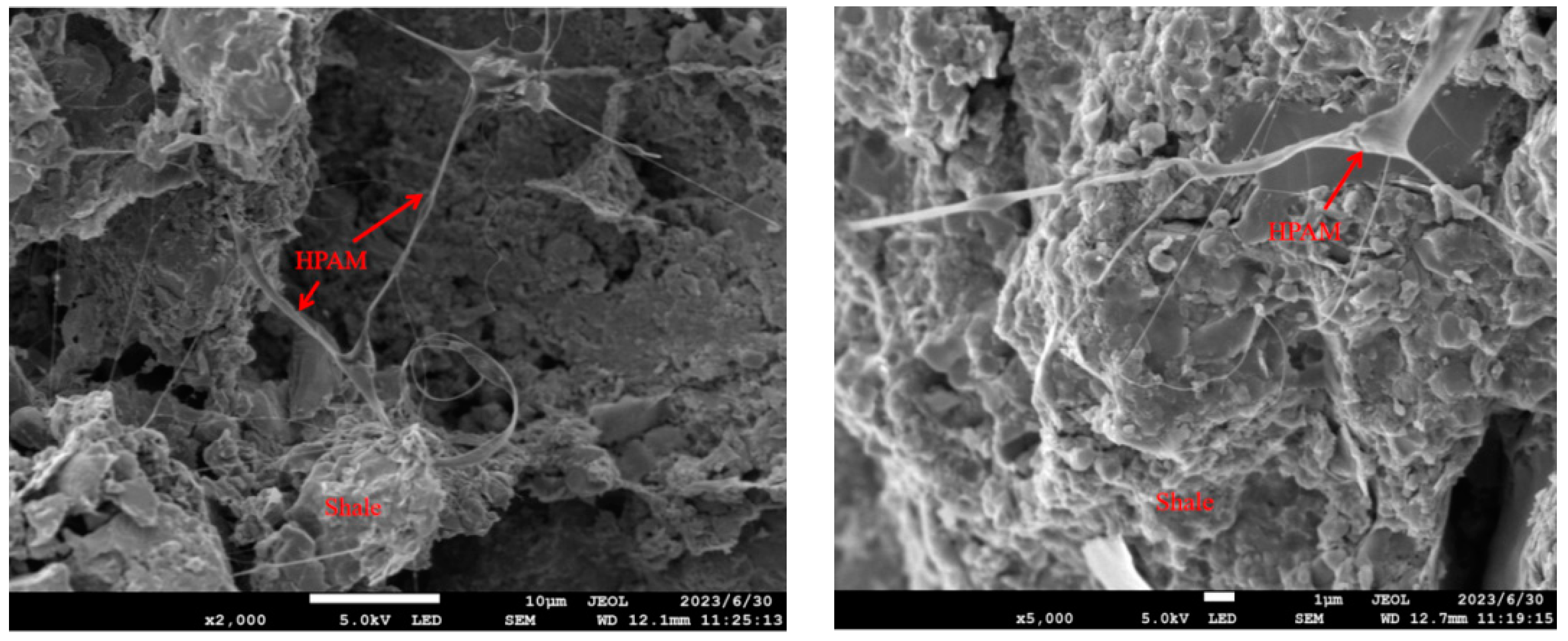Adsorption and Desorption Behavior of Partially Hydrolyzed Polyacrylamide on Longmaxi Shale
Abstract
1. Introduction
2. Experimental Details
2.1. Experimental Materials and Equipment
2.2. Experimental Methods
2.2.1. Method for Determination of Shale Clay Fractions
2.2.2. Determination of HPAM Concentration and Adsorption and Desorption Test Experiments
2.2.3. Adsorption Test of HPAM by Liquid–Solid Ratio
2.2.4. HPAM Adsorption Isotherm Test
2.2.5. HPAM Adsorption Kinetics Test
2.2.6. Microstructural Analysis of Shale with Adsorbed HPAM
2.2.7. HPAM Desorption Test
3. Experimental and Analysis
3.1. Mineral Composition of Shale Clay
3.2. Effect of Liquid–Solid Ratio on Adsorption of HPAM
3.3. HPAM Adsorption Isotherm
3.4. HPAM Adsorption Kinetics
3.5. Microstructure
3.6. Desorption Performance
4. Conclusions
Author Contributions
Funding
Data Availability Statement
Conflicts of Interest
Abbreviations
| PAM | Polyacrylamide | |
| HPAM | Partially hydrolyzed polyacrylamide | |
| CPAM | Cationic polyacrylamide | |
| PFO | The pseudo-first order | |
| PSO | The pseudo-second order | |
| SEM | Scanning electron microscope | |
| XRD | X-ray diffraction | |
| SD | Standard deviation | |
| Symbols Used | ||
| H | [--] | Solid–liquid ratio |
| C0 | [mg/L] | Initial concentration of HPAM |
| C | [mg/L] | HPAM concentration at adsorption equilibrium |
| C1 | [μg/L] | Concentration after desorption equilibrium |
| C2 | [μg/L] | Difference between initial HPAM concentration and concentration at adsorption equilibrium |
| Ce | [mg/L] | Liquid phase equilibrium concentration |
| Cr | [μg/g] | Concentration of HPAM remaining on shale surface after desorption |
| Ck | [--] | Regression constant |
| qe | [mg/g] | Adsorption equilibrium |
| V | [L] | Volume of HPAM solution |
| V1 | [L] | Volume of solution after desorption equilibrium |
| qo | [mg/g] | Maximum adsorption per unit mass of surfactant |
| KL | [L/mg] | Langmuir constant |
| KF | [L/mg] | The intercept of the linear expression of the Freundlich model, i.e., lnb. |
| R2 | [--] | The overall accuracy of the model, i.e., the degree of fit |
| b | [L/mg] | Adsorption capacity |
| n | [--] | Adsorption strength |
| qt | [mg/g] | Adsorption at time t |
| k1 | [min−1] | Adsorption rate factor |
| t | [min] | Adsorption time |
| k2 | [g/(mg·min)] | Adsorption rate factor |
| λ | [--] | Trend of C with H |
| ∂ | [--] | Trend of C with H |
| ω | [g] | Shale quality |
| Γd | [μg/g] | Amount of HPAM adsorbed at desorption equilibrium |
| Γ | [mg/g] | Amount of HPAM adsorbed at adsorption equilibrium |
Appendix A
| Sapphire % | Plagioclase % | Calcite % | Dolomite % | Pyrite % | Clay % | |
|---|---|---|---|---|---|---|
| 1 | 9.3 | 3.3 | 13.5 | 62.6 | 6.2 | 5.1 |
| 2 | 10.5 | 4.1 | 11.3 | 57.8 | 9.1 | 7.2 |
| 3 | 8.6 | 3.7 | 13.7 | 65.4 | 5.7 | 2.9 |
| Average | 9.47 | 3.7 | 12.83 | 61.93 | 7.00 | 5.07 |
| SD | 0.96 | 0.40 | 1.33 | 3.84 | 1.84 | 2.15 |
| Adsorption Capacity mg/g | 5:1 | 10:1 | 15:1 | 20:1 | 25:1 | 30:1 | 35:1 |
|---|---|---|---|---|---|---|---|
| 1000 mg/L | 0.59 | 0.70 | 0.73 | 1.03 | 1.08 | 1.07 | 1.05 |
| 1000 mg/L | 0.64 | 0.65 | 0.76 | 1.04 | 1.04 | 1.05 | 1.06 |
| 1000 mg/L | 0.57 | 0.66 | 0.76 | 1.05 | 1.03 | 1.06 | 1.04 |
| Average | 0.60 | 0.67 | 0.75 | 1.04 | 1.05 | 1.06 | 1.05 |
| SD | 0.036 | 0.026 | 0.017 | 0.010 | 0.026 | 0.010 | 0.010 |
| 500mg/L | 0.42 | 0.46 | 0.54 | 0.60 | 0.73 | 0.73 | 0.73 |
| 500mg/L | 0.46 | 0.42 | 0.55 | 0.63 | 0.69 | 0.71 | 0.68 |
| 500mg/L | 0.41 | 0.47 | 0.53 | 0.60 | 0.68 | 0.72 | 0.69 |
| Average | 0.43 | 0.45 | 0.54 | 0.61 | 0.70 | 0.72 | 0.70 |
| SD | 0.026 | 0.026 | 0.010 | 0.017 | 0.026 | 0.010 | 0.026 |
| Adsorption Capacity mg/g | 100 mg/L | 200 mg/L | 500 mg/L | 800 mg/L | 1000 mg/L | 1500 mg/L | 2000 mg/L |
|---|---|---|---|---|---|---|---|
| 30 °C | 0.25 | 0.43 | 0.68 | 0.97 | 1.02 | 1.08 | 1.05 |
| 30 °C | 0.23 | 0.42 | 0.71 | 0.93 | 1.09 | 1.06 | 1.04 |
| 30 °C | 0.21 | 0.47 | 0.74 | 0.95 | 1.04 | 1.04 | 1.06 |
| Average | 0.23 | 0.44 | 0.71 | 0.95 | 1.05 | 1.06 | 1.05 |
| SD | 0.020 | 0.026 | 0.03 | 0.020 | 0.036 | 0.020 | 0.010 |
| 60 °C | 0.16 | 0.30 | 0.53 | 0.70 | 0.70 | 0.72 | 0.76 |
| 60 °C | 0.14 | 0.30 | 0.53 | 0.69 | 0.69 | 0.68 | 0.68 |
| 60 °C | 0.18 | 0.33 | 0.47 | 0.74 | 0.74 | 0.73 | 0.72 |
| Average | 0.16 | 0.31 | 0.51 | 0.71 | 0.71 | 0.71 | 0.72 |
| SD | 0.020 | 0.017 | 0.036 | 0.026 | 0.026 | 0.026 | 0.040 |
| Time/min | 10 | 20 | 30 | 40 | 60 | 90 | 120 | |
|---|---|---|---|---|---|---|---|---|
| 30 °C | 500 mg/L | 0.23 | 0.35 | 0.45 | 0.47 | 0.65 | 0.66 | 0.71 |
| 500 mg/L | 0.16 | 0.31 | 0.44 | 0.55 | 0.67 | 0.73 | 0.67 | |
| 500 mg/L | 0.21 | 0.36 | 0.40 | 0.48 | 0.69 | 0.71 | 0.75 | |
| Average | 0.20 | 0.34 | 0.43 | 0.50 | 0.67 | 0.70 | 0.71 | |
| SD | 0.036 | 0.026 | 0.026 | 0.044 | 0.020 | 0.035 | 0.040 | |
| 1000 mg/L | 0.27 | 0.47 | 0.65 | 0.75 | 0.88 | 1.01 | 1.07 | |
| 1000 mg/L | 0.24 | 0.51 | 0.63 | 0.70 | 0.91 | 1.01 | 1.06 | |
| 1000 mg/L | 0.24 | 0.52 | 0.61 | 0.74 | 0.91 | 1.04 | 1.02 | |
| Average | 0.25 | 0.50 | 0.63 | 0.73 | 0.90 | 1.02 | 1.05 | |
| SD | 0.017 | 0.026 | 0.020 | 0.026 | 0.017 | 0.017 | 0.026 | |
| 60 °C | 500 mg/L | 0.13 | 0.26 | 0.33 | 0.50 | 0.50 | 0.47 | 0.49 |
| 500 mg/L | 0.15 | 0.25 | 0.29 | 0.47 | 0.51 | 0.52 | 0.53 | |
| 500 mg/L | 0.14 | 0.21 | 0.31 | 0.47 | 0.49 | 0.51 | 0.51 | |
| Average | 0.14 | 0.24 | 0.31 | 0.48 | 0.50 | 0.50 | 0.51 | |
| SD | 0.511 | 0.026 | 0.020 | 0.017 | 0.010 | 0.026 | 0.020 | |
| 1000 mg/L | 0.20 | 0.38 | 0.47 | 0.59 | 0.73 | 0.73 | 0.69 | |
| 1000 mg/L | 0.18 | 0.36 | 0.44 | 0.56 | 0.69 | 0.71 | 0.72 | |
| 1000 mg/L | 0.16 | 0.34 | 0.44 | 0.56 | 0.68 | 0.69 | 0.75 | |
| Average | 0.18 | 0.36 | 0.45 | 0.57 | 0.70 | 0.71 | 0.72 | |
| SD | 0.020 | 0.020 | 0.015 | 0.017 | 0.026 | 0.020 | 0.030 | |
| Water–Solid Ratio | Residual HPAM Concentration after Desorption (μg/g) | |
|---|---|---|
| Desorption of HPAM Concentration 1000 mg/L after Adsorption on Shale Rock | Desorption of HPAM Concentration 500 mg/L after Adsorption on Shale Rock | |
| 1:1 | 1051.1 | 703.6 |
| 1:1 | 1051.3 | 694.3 |
| 1:1 | 1048.2 | 703.6 |
| Average | 1050.2 | 700.5 |
| SD | 1.735 | 5.369 |
| 2:1 | 1000.7 | 683.2 |
| 2:1 | 998.2 | 683.9 |
| 2:1 | 1005.0 | 683.4 |
| Average | 1001.3 | 683.5 |
| SD | 3.439 | 0.361 |
| 3:1 | 949.9 | 638.7 |
| 3:1 | 954.6 | 643.2 |
| 3:1 | 955.4 | 638.7 |
| Average | 953.3 | 640.2 |
| SD | 2.972 | 2.598 |
| 5:1 | 882.6 | 580.0 |
| 5:1 | 875.3 | 584.5 |
| 5:1 | 869.2 | 580.3 |
| Average | 875.7 | 581.6 |
| SD | 6.709 | 2.516 |
| 10:1 | 750.0 | 512.0 |
| 10:1 | 755.8 | 508.2 |
| 10:1 | 762.8 | 511.7 |
| Average | 756.2 | 510.8 |
| SD | 6.409 | 2.113 |
| 20:1 | 626.4 | 450.8 |
| 20:1 | 634.2 | 453.2 |
| 20:1 | 629.7 | 448.1 |
| Average | 630.1 | 450.7 |
| SD | 3.915 | 2.551 |
| 25:1 | 578.5 | 432.0 |
| 25:1 | 577.3 | 427.1 |
| 25:1 | 582.1 | 433.6 |
| Average | 579.3 | 430.9 |
| SD | 2.498 | 3.387 |
| 30:1 | 525.9 | 423.7 |
| 30:1 | 522.5 | 425.6 |
| 30:1 | 525.7 | 422.1 |
| Average | 524.7 | 423.8 |
| SD | 1.908 | 1.752 |
| 35:1 | 513.8 | 419.6 |
| 35:1 | 512.4 | 422.1 |
| 35:1 | 519.4 | 419.2 |
| Average | 515.2 | 420.3 |
| SD | 3.704 | 1.571 |
References
- Palisch, T.T.; Vincent, M.C.; Handren, P.J. Slickwater Fracturing: Food for Thought. SPE Prod. Oper. 2010, 25, 327–344. [Google Scholar] [CrossRef]
- Liu, Z.; Bai, B.; Wang, Y.; Qu, H.; Ding, Z.; Xiao, Q. Experimental Study of Slickwater Volume Effect on Methane Desorption on Longmaxi Shale. J. Nat. Gas Sci. Eng. 2021, 91, 103950. [Google Scholar] [CrossRef]
- Sun, H.; Wood, B.; Stevens, D.; Cutler, J.; Qu, Q.; Lu, M. A Nondamaging Friction Reducer for Slickwater Frac Applications. In Proceedings of the SPE Hydraulic Fracturing Technology Conference, The Woodlands, TX, USA, 24–26 January 2011. [Google Scholar]
- Paktinat, J.; Oneil, B.; Tulissi, M.G. Case Studies: Impact of High Salt Tolerant Friction Reducers on Freshwater Conversation in Canadian Shale Fracturing Treatments. Carbon 2011, 10, 343. [Google Scholar]
- Ibrahim, A.F.; Nasr-El-Din, H.A.; Rabie, A.; Lin, G.; Zhou, J.; Qu, Q. A New Friction-Reducing Agent for Slickwater-Fracturing Treatments. SPE Prod. Oper. 2018, 33, 583–595. [Google Scholar] [CrossRef]
- Xu, J.; Yuan, Y.; Feng, Z.; Liu, F.; Zhang, Z. Molecular dynamics simulation of adsorption and diffusion of partially hydrolyzed polyacrylamide on kaolinite surface. J. Mol. Liq. 2022, 367, 120377. [Google Scholar] [CrossRef]
- Lew, J.H.; Matar, O.K.; Müller, E.A.; Maung, M.T.M.; Luckham, P.F. Adsorption of Hydrolyzed Polyacrylamide onto Calcium Carbonate. Polymers 2022, 14, 405. [Google Scholar] [CrossRef] [PubMed]
- Cheraghian, G.; Nezhad, S.S.K.; Kamari, M.; Hemmati, M.; Masihi, M.; Bazgir, S. Adsorption polymer on reservoir rock and role of the nanoparticles, clay and SiO2. Int. Nano Lett. 2014, 4, 114. [Google Scholar] [CrossRef]
- Mohan, A.; Rao, A.; Vancso, J.; Mugele, F. Towards enhanced oil recovery: Effects of ionic valency and pH on the adsorption of hydrolyzed polyacrylamide at model surfaces using QCM-D. Appl. Surf. Sci. 2021, 560, 149995. [Google Scholar] [CrossRef]
- Li, Y.; Wang, S.; Guo, J.; Gou, X.; Jiang, Z.; Pan, B. Reduced adsorption of polyacrylamide-based fracturing fluid on shale rock using urea. Energy Sci. Eng. 2018, 6, 749–759. [Google Scholar] [CrossRef]
- Xu, J.; Wang, X.; Chen, J.; Ding, T.; Xue, J. Inhibition mechanism of cationic polyacrylamide on montmorillonite surface hydration: A molecular dynamics simulation study. Chem. Phys. 2023, 567, 111792. [Google Scholar] [CrossRef]
- Xu, C.; Kang, Y.; You, Z.; Chen, M. Review on formation damage mechanisms and processes in shale gas reservoir: Known and to be known. J. Nat. Gas Sci. Eng. 2016, 36, 1208–1219. [Google Scholar] [CrossRef]
- Wu, X.; Pu, H.; Zhu, K.; Lu, S. Formation damage mechanisms and protection technology for Nanpu nearshore tight gas reservoir. J. Pet. Sci. Eng. 2017, 158, 509–515. [Google Scholar] [CrossRef]
- Guan, S.; Fan, H.; Wu, S. Examnation of the concentra-tion of HPAM: The turbidity method. J. Daqing Petro-Leum Inst. 2007, 31, 106–109. [Google Scholar]
- Lyu, K.; Dai, C.; Zhang, R.; Liu, X.; Zhang, J.; Yang, N. Study on adsorption characteristics of hydrophobically associating polymers in formation porous media. Oilfield Chem. 2010, 27, 391–394. [Google Scholar]
- Xu, Z.; Cai, J.; Pan, B. Mathematically modeling fixed-bed adsorption in aqueous systems. J. Zhejiang Univ. Sci. A 2013, 14, 155–176. [Google Scholar] [CrossRef]
- Kalam, S.; Abu-Khamsin, S.A.; Kamal, M.S.; Patil, S. Surfactant Adsorption Isotherms: A Review. ACS Omega 2021, 6, 32342–32348. [Google Scholar] [CrossRef]
- Xia, L.; Tan, K.; Deng, C.; Chen, Z.; Zheng, W.; Wang, X. Adsorptive power ofuranium by the activated sludge and its mechanism. J. Saf. Environ. 2010, 10, 41–45. [Google Scholar]
- Xiao, Q.; Sun, H.; Yang, Y.; Zheng, J.; Feng, W. Adsorption properties of polyacrylamide on pulverized coal. Drill. Fluid Complet. Fluid 2013, 30, 46–48. [Google Scholar]
- Zhang, X.; Ren, Y.; Wei, C.; Chen, J. Adsorption mechanism of organic pollutants from biologically treated coking wastewater by powdered activated carbon. Acta Sci. Circumstantiae 2007. [Google Scholar] [CrossRef]
- Jain, R.; Sharma, P.; Sikarwar, S. Kinetics and isotherm analysis of tropaeoline adsorption onto unsaturated polyester resin (UPR): A non-carbon adsorbent. Environ. Sci. Pollut. Res. 2013, 20, 1493–1502. [Google Scholar] [CrossRef]
- Rahchamani, J.; Mousavi, H.; Behzad, M. Adsorption of methyl violet from aqueous solution by polyacrylamide as an adsorbent: Isotherm and kinetic studies. Desalination 2011, 267, 256–260. [Google Scholar] [CrossRef]
- Chen, Z.; Li, J.; Zhang, M.; Yan, M.; Lin, Q.; Wu, Q. Crop effects of soil phosphorus desorption model and its characteristic values. Ecol. Environ. Sci. 2007, 163–169. [Google Scholar] [CrossRef]
- Wu, Q.-T.; Xu, Z.; Meng, Q.; Gerard, E.; Morel, J.-L. Characterization of cadmium desorption in soils and its relationship to plant uptake and cadmium leaching. Plant Soil 2004, 258, 217–226. [Google Scholar] [CrossRef]







| Parameter | 30 °C | 60 °C |
|---|---|---|
| KL (L/mg) | 0.00168 | 0.00160 |
| qo (mg/g) | 1.61574 | 1.17306 |
| R2 | 0.99207 | 0.99235 |
| Equation | y = 368.27656x + 0.61891 | y = 531.18109x + 0.85247 |
| Parameter | 30 °C | 60 °C |
|---|---|---|
| 1/n | 0.63964 | 0.64632 |
| KF | 0.01327 | 0.00905 |
| R2 | 0.98172 | 0.97346 |
| Equation | y = 0.63964x − 4.32162 | y = 0.64632x − 4.70539 |
| Temperature (°C) | Model | Concentration (mg/L) | Parameter Estimation Results | Modeling Evaluation | Equation | |
|---|---|---|---|---|---|---|
| Parameter | Estimated Value | R2 | ||||
| 30 °C | PFO | 500 mg/L | K1 | 0.05808 | 0.92439 | y = −0.05803x + 0.28552 |
| 1000 mg/L | K1 | 0.03993 | 0.97147 | y = −0.03993x + 0.33437 | ||
| PSO | 500 mg/L | K2 | 0.0168 | 0.99016 | y = 1.05518x + 36.32215 | |
| 1000 mg/L | K2 | 0.007 | 0.98879 | y = 0.68303x + 27.77111 | ||
| 60 °C | PFO | 500 mg/L | K1 | 0.07737 | 0.95985 | y = −0.07737x − 0.0309 |
| 1000 mg/L | K1 | 0.04789 | 0.96776 | y = −0.04789x + 0.05604 | ||
| PSO | 500 mg/L | K2 | 1.58226 | 0.96019 | y = 1.58226x + 37.13914 | |
| 1000 mg/L | K2 | 0.98338 | 0.97547 | y = 0.98338x + 35.07034 | ||
| Desorption after Shale Adsorption | Ck | ∂ | λ | R2 | Equation |
|---|---|---|---|---|---|
| HPAM solution concentration 500 mg/L | 724.6009 | 0.1233 | 0.0040 | 0.9770 | Cr = 724.6009H−0.1233e−0.0040 |
| HPAM solution concentration 1000 mg/L | 1078.9436 | 0.0898 | 0.0131 | 0.9950 | Cr = 1078.9436H−0.0898e−0.0131 |
Disclaimer/Publisher’s Note: The statements, opinions and data contained in all publications are solely those of the individual author(s) and contributor(s) and not of MDPI and/or the editor(s). MDPI and/or the editor(s) disclaim responsibility for any injury to people or property resulting from any ideas, methods, instructions or products referred to in the content. |
© 2024 by the authors. Licensee MDPI, Basel, Switzerland. This article is an open access article distributed under the terms and conditions of the Creative Commons Attribution (CC BY) license (https://creativecommons.org/licenses/by/4.0/).
Share and Cite
Li, J.; Luo, T.; Cheng, T.; Lei, Y.; Xing, Y.; Pan, B.; Fu, X. Adsorption and Desorption Behavior of Partially Hydrolyzed Polyacrylamide on Longmaxi Shale. Processes 2024, 12, 606. https://doi.org/10.3390/pr12030606
Li J, Luo T, Cheng T, Lei Y, Xing Y, Pan B, Fu X. Adsorption and Desorption Behavior of Partially Hydrolyzed Polyacrylamide on Longmaxi Shale. Processes. 2024; 12(3):606. https://doi.org/10.3390/pr12030606
Chicago/Turabian StyleLi, Jun, Taotao Luo, Tingting Cheng, Ying Lei, Yameng Xing, Bin Pan, and Xiao Fu. 2024. "Adsorption and Desorption Behavior of Partially Hydrolyzed Polyacrylamide on Longmaxi Shale" Processes 12, no. 3: 606. https://doi.org/10.3390/pr12030606
APA StyleLi, J., Luo, T., Cheng, T., Lei, Y., Xing, Y., Pan, B., & Fu, X. (2024). Adsorption and Desorption Behavior of Partially Hydrolyzed Polyacrylamide on Longmaxi Shale. Processes, 12(3), 606. https://doi.org/10.3390/pr12030606





